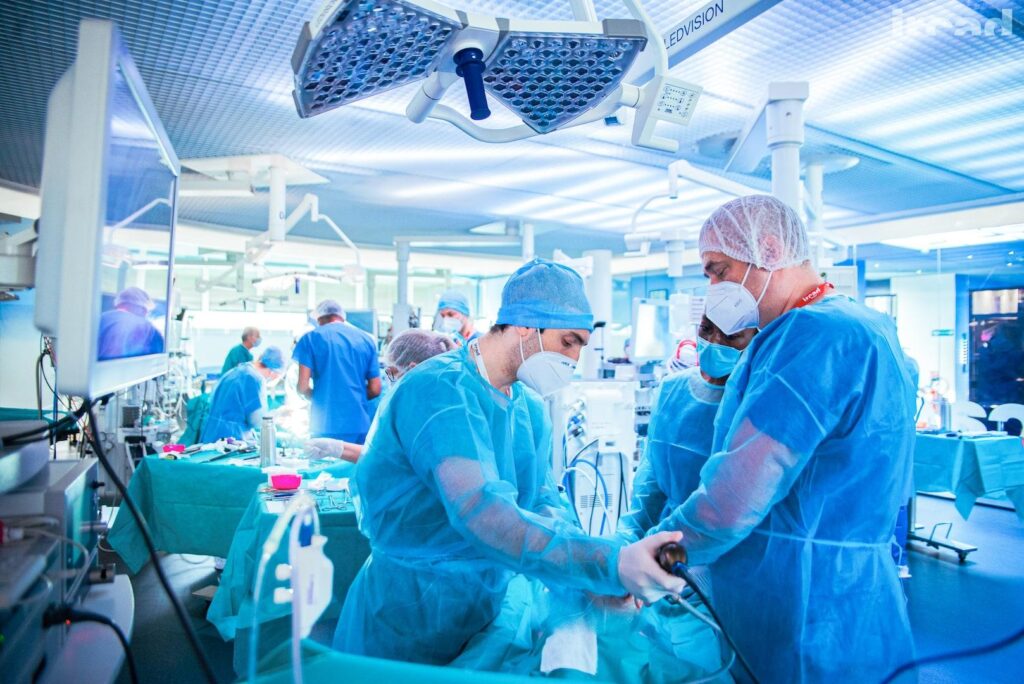Thoracic surgery deals with the organs of the chest as well as the esophagus (tube connecting the mouth and stomach), trachea (airway), and chest wall (rib cage and breastbone). To ensure you receive complete, innovative, and supportive care, specialized surgeons collaborate closely with colleagues in gastroenterology, oncology, pulmonology, radiation oncology, and other disciplines.
To provide you with comprehensive care, thoracic surgeons interact with professionals from a variety of specialties. Radiologists, pathologists, pulmonologists, gastroenterologists, oncologists, and specialists in a variety of other specialties, as well as nurse practitioners and physician assistants, make up your integrated care team.
What is Thoracic Surgery?
Thoracic surgery, often known as chest surgery, is a type of surgery that is performed to diagnose or treat lungs that have been damaged by cancer, trauma, or pulmonary illness. To diagnose, stage, and treat lung cancer, your surgeon may remove nodules, tumors, and lymph nodes.
Minimally invasive techniques or an open surgical procedure known as a thoracotomy are both options for thoracic surgery. When extensive sections of the lung or the inner chest cavity must be seen, your surgeon may choose a thoracotomy. The operation can be used to remove the complete lung or just a part of it.
What is Cardiothoracic Surgery?
Cardiovascular (heart and blood vessel) and pulmonary (lung) surgery make up cardiothoracic surgery. It is used to diagnose and treat heart, lung, and other allied structures like the trachea (windpipe), esophagus (feeding tube), diaphragm disorders, and traumatic injuries.
Cardiothoracic surgery is performed by a cardiothoracic surgeon, who is a general surgeon. Some cardiothoracic surgeons are experts in complex surgeries like heart and lung transplants.
Depending upon the surgical process types of cardiothoracic surgery can take place:
- Open Surgery
- Endoscopic Surgery (Laparoscopic or thoracoscopic)
- Robotic Surgery
Purpose of Cardiothoracic Surgery
Cardiothoracic surgeries are used to diagnose and treat a wide range of pulmonary, cardiovascular, and gastrointestinal diseases and disorders, as well as esophageal difficulties.
It is used for medical emergencies (such as a heart attack or a catastrophic chest injury) as well as routine treatments (when non-surgical options have been either exhausted or are considered inadequate). Cardiovascular surgery is considered the standard of care for several conditions, such as lung cancer.
Cardiothoracic surgery can be performed on adults, children, and infants, and specialist in-utero treatments can even be used on unborn newborns.
Pre-Operative Evaluation
Pre-operative testing will be performed if cardiothoracic surgery is indicated to ensure that you are a candidate for surgery and to help direct the procedure’s course, including the type of anesthetic utilized.
In addition, the cardiothoracic surgeon will do a series of tests and procedures to improve surgery planning and detect vulnerabilities that could affect a patient’s response to the anesthetic, risk of complications, or recovery.
These pre-operative tests, often known as the diagnostic workup, are ordered well in advance of surgery. They include blood tests such as liver function tests (LFTs), kidney function tests (KFT’s), complete blood count (CBC), and blood coagulation tests to determine how well organs are working. Imaging investigations can aid in planning the surgical approach and determining the best surgical method.
The following factors may be included in a cardiovascular surgery diagnostic workup:
- Cardiac Catheterization
- Chest Computed Tomography
- Coronary Angiogram
- Electrocardiogram (ECG)
- Myocardial Biopsy and Ultrasound
The following workups may be included in a pulmonary surgery diagnostic workup:
- Bronchoscopy
- Chest X-Ray
- MRI
- Pulmonary Function Tests
- Positron Emission Tomography (PET)
- Esophageal Endoscopy
How to Prepare Patient For Surgery
General anesthetic, regional blocks with intravenous sedation, or local anesthesia with intravenous sedation are commonly used in cardiothoracic surgery. There are food and drink limitations in all three cases.
Food and drink restrictions are in place to prevent food or liquids from being accidentally aspirated into the lungs during surgery. They are applicable regardless of whether the procedure is minor or major.
Prior to cardiothoracic surgery, your surgeon will present you with a list of medications you must cease using. Drugs that encourage bleeding, hinder blood clotting, influence blood sugar levels, or intensify the effects of anesthesia are examples of these.
The following medicines are the most typically affected:
- Anticoagulants
- Aspirin
- Beta-blockers
- Diabetes Medications
- Non-Steroidal Anti-Inflammatory Drugs (NSAIDs)
Procedure
Different types of thoracic surgery procedures involve the following:
Before surgery
Before undergoing thoracic surgery and thoracic spine surgery, a patient will go through a series of common procedures. After you’ve put on your hospital gown, a nurse will:
- Record your height and weight
- Make a note of vital signs
- Set up ECG monitoring
- Set up Pulse Oximetry
- Place an intravenous catheter
During Surgery
The anesthesiologist selects and administers anesthesia to ensure a safe and comfortable surgery with little risk.
The procedure might begin after the patient has been sedated. What occurs next is determined by the type of surgery you are having and the technique utilized to carry it out. Given the wide range of treatments that a cardiothoracic surgeon is trained to do, there are various options.
For example, tracheal stenosis (narrowing) surgery involves placing a stent to keep the airway open, whereas a lobectomy involves physically removing a lung lobe.
Some surgeries necessitate the insertion of a temporary chest tube to aid in the drainage of collected fluids from the chest cavity and/or the re-inflating of the lungs following lung surgery.
Depending on the extent of the procedure, cardiothoracic surgery can take a few to many hours.
After Procedure
If significant surgery is performed, you will be transported to the post-anesthesia care unit (PACU), where you will be monitored until you are fully recovered from anesthesia, or directly to the intensive care unit (ICU).
The length of hospitalization varies per surgery and may include a brief stay for observation (i.e., to ensure that complications do not arise or to establish whether a response has been reached) or a longer stay for recovery and rehabilitation in the hospital.
Recovery Rate
Cardiothoracic surgery in India is always followed by a time of recovery and, in most cases, an organized rehabilitation program.
A physical therapist who specializes in cardiopulmonary disorders is generally in charge of the rehabilitation efforts. Some of the procedures are carried out in the hospital, while others are carried out at home on a regular basis.
You will also need to see your surgeon on a regular basis to check that you are mending well, as well as your cardiologist, pulmonologist, gastroenterologist, or oncologist, to ensure that the treated condition is being managed effectively.







